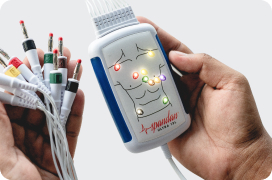
Author:- Mr. Ritesh Sharma
AWMI full form in medical has always been a topic of debate in healthcare. This is because when it comes to the vast and intricate world of medical terminology, abbreviations play a crucial role in simplifying complex concepts and facilitating efficient communication among healthcare professionals. One of these abbreviations is AWMI. The AWMI full form in medical is Acute Wall Motion Index. The AWMI full form in medical is an extremely important parameter in assessing heart health.
This parameter is used by healthcare professionals to gauge the functionality of the heart’s walls during the time of contraction. The AWMI full form in medical field serves as a vivid insight into the functioning of the heart. Much like other functions of the heart such as the prevention of mixing of oxygenated and deoxygenated blood controlled by the septum, or valves that prevent the backflow of blood to the heart, AWMI also has great significance.
This parameter calculates the movement of the heart’s walls during the contraction phase. Furthermore, this parameter comes in handy in detecting several clinical implications associated with the functioning of the heart. In this blog, we will uncover all the details related to the AWMI full form in medical. This includes the meaning, significance, and application of AWMI in the medical field.
What is AWMI Full Form in Medical?
AWMI (Acute Wall Motion Index) is a diagnostic measurement used to evaluate the movement of the walls of the heart, specifically the left ventricle, during the cardiac cycle. The heart’s walls need to contract and relax efficiently to pump blood effectively throughout the body. Any impairment in this motion can indicate various cardiac conditions, most notably myocardial infarction (heart attack) and other forms of ischemic heart disease.
The assessment of wall motion is typically performed using imaging techniques such as echocardiography (ultrasound of the heart), cardiac MRI (Magnetic Resonance Imaging), or nuclear imaging. These techniques allow healthcare professionals to visualize the heart in real-time and determine how well the heart muscle is functioning.
The Importance of AWMI
The AWMI is particularly crucial for several reasons:
- Early Detection of Heart Disease: One of the primary benefits of assessing the Acute Wall Motion Index is its ability to aid in the early detection of heart diseases. Abnormal wall motion can be one of the first signs of ischemia (insufficient blood flow to the heart muscle) or infarction. Early detection allows for timely intervention, which can significantly improve patient outcomes.
- Evaluation of Heart Attack Severity: In patients who have suffered a myocardial infarction, the AWMI can help determine the extent and severity of the damage. This is vital for planning the appropriate treatment strategy and for prognosticating the patient’s recovery.
- Guiding Treatment Decisions: The information derived from the AWMI can influence clinical decisions. For instance, patients with significant wall motion abnormalities might require more aggressive treatments, such as revascularization procedures (like angioplasty or coronary artery bypass grafting) or medical therapies aimed at improving heart function.
- Monitoring Treatment Efficacy: For patients undergoing treatment for cardiac conditions, periodic assessment of the AWMI can help monitor the effectiveness of the treatment. Improvement in wall motion abnormalities can be a positive indicator of treatment success, while persistent or worsening abnormalities may necessitate a change in therapeutic approach.
How is AWMI Measured?
The measurement of the Acute Wall Motion Index involves analyzing the motion of the left ventricular walls during systole (contraction phase of the heart cycle). The left ventricle is typically divided into segments, and the motion of each segment is scored based on its movement. These segments might include:
- Basal
- Mid
- Apical
Each segment is assessed for its motion, which is classified into categories such as normal, hypokinetic (reduced motion), akinetic (no motion), and dyskinetic (abnormal motion, often outward instead of inward). The scores for each segment are then averaged to give an overall wall motion index.
Here’s a simplified scoring system:
- Normal: Normal inward motion (score 1)
- Hypokinetic: Reduced inward motion (score 2)
- Akinetic: Absence of inward motion (score 3)
- Dyskinetic: Outward motion (score 4)
The sum of these scores, divided by the number of segments, gives the Wall Motion Index. A higher index indicates more severe impairment of heart wall motion.
Clinical Applications of AWMI
- Diagnostic Tool: AWMI is primarily used as a diagnostic tool in cardiology. For instance, during a stress test, echocardiography can be used to evaluate wall motion both at rest and under stress conditions. This can help identify areas of the heart that are not receiving adequate blood flow.
- Risk Stratification: Patients with abnormal AWMI are at higher risk for adverse cardiac events. Thus, this index is often used in risk stratification to identify high-risk patients who may benefit from more intensive monitoring and therapy.
- Post-Myocardial Infarction Care: After a patient suffers a heart attack, assessing the AWMI can help gauge the extent of myocardial damage and guide post-infarction management strategies.
- Heart Failure Management: In patients with heart failure, particularly those with reduced ejection fraction, AWMI can provide insights into the underlying mechanisms and guide the adjustment of treatment regimens.
Challenges and Limitations
While AWMI is a valuable tool, it does have its limitations:
- Operator Dependency: The accuracy of wall motion assessment can vary based on the operator’s experience and expertise in interpreting cardiac images.
- Imaging Quality: The quality of the images obtained from echocardiography or other modalities can affect the reliability of the wall motion analysis. Factors such as patient body habitus and the presence of lung disease can impact image quality.
- Subjectivity: Although scoring systems are used, there is still a degree of subjectivity in evaluating wall motion, which can lead to inter-observer variability.
In conclusion, the AWMI full form in medical is one of the most important parameters in the field of healthcare. The walls of the heart during contraction contribute to the number of contractions in BPM. Therefore, even if this particular parameter is not widely discussed, it is necessary for healthcare professionals to study.




